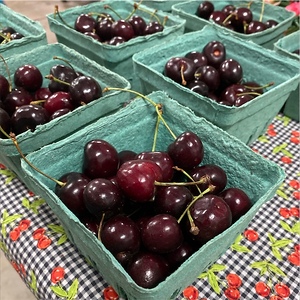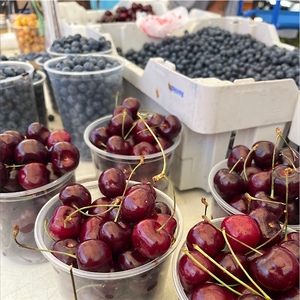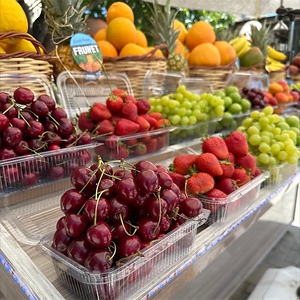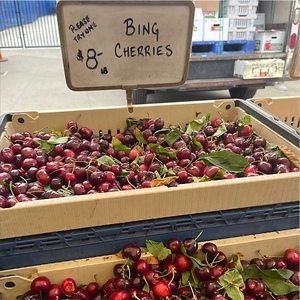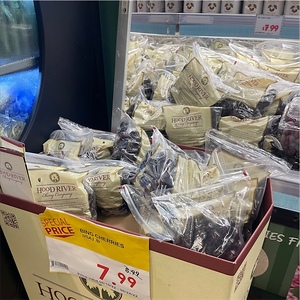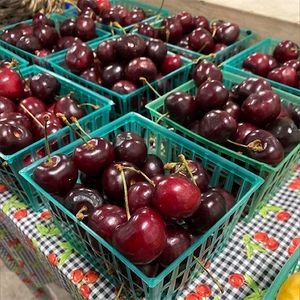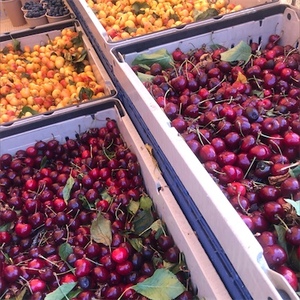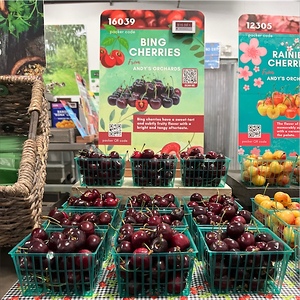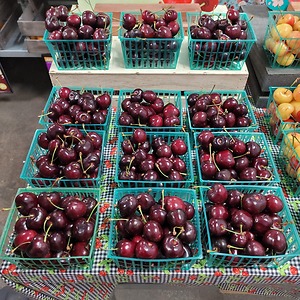

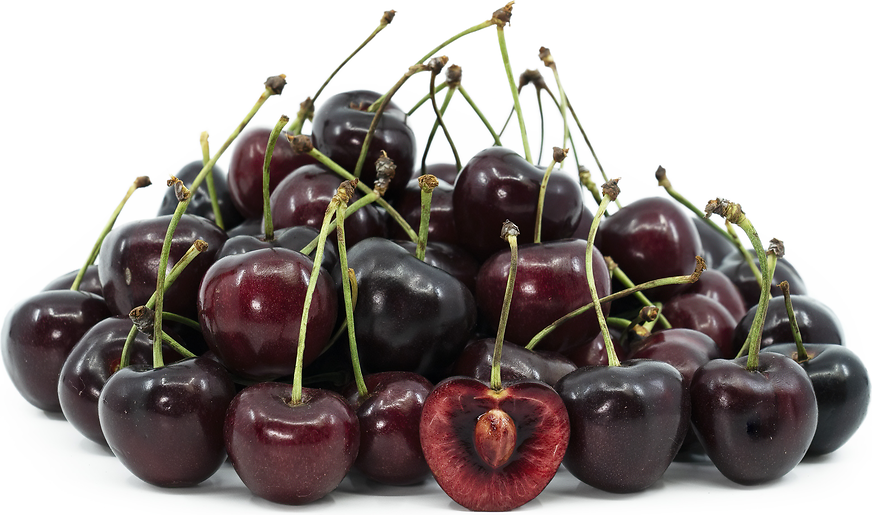
Bing Cherries
Estimated Inventory, lb : 0
This item was last sold on : 06/19/25
Description/Taste
Bing cherries are a medium to large varietal, averaging around two centimeters in diameter, and have a plump and uniform, round to cordate shape attached to a slender, green fibrous stem. The fruit’s skin is glossy, taut, semi-thin, and smooth, ranging from maroon to crimson to dark red, almost appearing black. Underneath the surface, the bright red flesh is striated with dark red hues, especially surrounding the pit, and has an aqueous and firm texture, containing a snap-like, crisp consistency. The flesh also contains a semi-freestone, light brown pit that is inedible and should be discarded. Bing cherries have a sweet-tart and subtly fruity flavor with a bright and tangy aftertaste.
Seasons/Availability
Bing cherries are available in California in the late spring through summer. In the Pacific Northwest, the cherries are in season in the summer through early fall. Bing cherries are also grown in both hemispheres, allowing the cherries to appear sporadically throughout the year in various fresh markets.
Current Facts
Bing cherries, botanically classified as Prunus avium, are a famous sweet cherry variety belonging to the Rosaceae family. The dark-colored cherries grow on deciduous trees that can reach 10 meters in height and are favored for their high yields, producing over 50 pounds of cherries annually. There are also dwarf Bing cherry trees that range 3 to 4 meters in height for home garden cultivation. Bing cherries require other trees for pollination and are often paired with van, black tartarian, lapins, or rainier cherries. The sweet-tart fruits are one of the most popularly cultivated varieties in the United States and are primarily grown for fresh markets. In Washington state, Bing cherries are so common that they are used as a benchmark to describe the seasonality of other cherry varieties. Many Washington orchards define the availability of cherry varieties by describing the number of days before or after Bing cherries are in season. Bing cherries are grown in commercial orchards and home gardens, valued for their drought tolerance, adaptability, and productive nature. The large fruits can also be transported without excessive damage and have a balanced flavor for both fresh and cooked preparations.
Nutritional Value
Bing cherries are an excellent source of vitamin A to maintain healthy organ functioning and contain antioxidants, including vitamin C, to strengthen the immune system, reduce inflammation, and protect cells against free radical damage. The cherries also provide calcium to protect bones and teeth, fiber to regulate the digestive tract, potassium to balance fluid levels within the body, and lower amounts of iron, magnesium, and vitamin K.
Applications
Bing cherries have a sweet-tart flavor well suited for fresh eating, cooking, canning, or freezing. The fruits can be consumed straight, out of hand, discarding the pit, or they can be dipped whole in chocolate as a healthy snack, sliced in half as a fresh topping over cereal, yogurt, parfaits, pancakes, and ice cream, or tossed into green and fruit salads. Bing cherries can also be blended into smoothies or juiced for fruit punches, sparkling beverages, cocktails, or sangria. In addition to fresh preparations, Bing cherries have a sweet taste popularly used as a flavoring in desserts. The fruits can also be simmered into jams, syrups, preserves, and compotes, or they can be incorporated into bread, scones, cobblers, cakes, and pies. Beyond sweet preparations, Bing cherries can be cooked into sauces and served over savory dishes, including roasted meats and stuffing. Bing cherries pair well with spices such as cinnamon, nutmeg, and cardamom, meats including poultry, pork, duck, and turkey, cheeses such as burrata, brie, and mascarpone, herbs such as basil, cilantro, and mint, vanilla, peaches, berries, and apricots. Whole, unwashed Bing cherries will keep 5 to 7 days when stored in the coldest part of the refrigerator. The fruits are harvested when ripe, and they do not continue to ripen off the tree. Bing cherries can also be frozen or canned for extended use.
Ethnic/Cultural Info
Bing cherries are a part of a unique history of the Lewelling, sometimes spelled Luelling brothers and the establishment of commercial orchards in the Pacific Northwest. Henderson and Seth Lewelling were Iowa-based businessmen who were also Quakers, a group of people focused on simplicity, standing up for the marginalized, and following primitive Christianity. In 1847, as the news of available land in the Pacific Northwest spread across the country, Henderson Lewelling left Iowa in search of new opportunities. Henderson transported approximately 700 fruit trees from Iowa to the Willamette Valley in Oregon. Henderson’s brother Seth eventually joined him in Oregon, and the brothers established a commercial nursery near the city of Milwaukie, Oregon. This nursery was where Bing cherries were first created, and the variety was named after the nursery’s head foreman. Ah Bing was a Chinese immigrant of Manchurian descent and worked for the brothers for over 35 years. During his career as foreman, Bing worked closely with Seth Lewelling in the cherry orchards, selectively breeding and developing new cherry varieties. According to expert sources, Bing was walking with Lewelling through the orchard one day in 1875 when they noticed a new type of cherry growing on one of the trees. Lewelling selected the new cherry for commercial propagation and decided to name the variety after Bing to honor his hard work and dedication to the farm. The new cultivar was also discovered in the row of trees that were assigned to Bing. After the cherry’s discovery, Bing returned home to China in 1889 to visit his family. While he was visiting, tensions rose in the Pacific Northwest against Chinese workers due to the Chinese Exclusion Act of 1882. New restrictions were placed on travel, and borders were sealed, preventing Bing from returning to the United States. Experts state that Bing did not leave records or any information behind, leading Bing cherries to be the only memory of the foreman.
Geography/History
Bing cherries were first discovered growing in the orchard of Seth Lewelling in 1875 in the Willamette Valley, Oregon, near the city of Milwaukie. The cherries were believed to be an open-pollinated cross between black republican and royal ann cherries, also known as napoleon cherries in France. The variety was selected for its large size, uniform shape, sweet-tart flavor, and pigmented coloring, as it was the only dark red cultivar produced in the Pacific Northwest during the late 19th century. Today Bing cherries are one of the most commercially produced varieties in the United States. The cherries favor a dry summer climate and grow especially well in California and the Pacific Northwest, specifically Washington and Oregon. The fruits are also cultivated in Wisconsin, British Columbia, and Chile. When in season, Bing cherries are widely found through farmer’s markets, distributors, and grocers.
Featured Restaurants
Restaurants currently purchasing this product as an ingredient for their menu.
| Pizzeria Luigi | San Diego CA | 610-539-7025 |
| Kettner Exchange | San Diego CA | 909-915-9877 |
| Lodge at Torrey Pines Main | San Diego CA | 858-453-4420 |
| Alila Marea Beach Resort | Encinitas CA | 805-539-9719 |
| Mission Pacific | Oceanside CA | 760-450-7864 |
| Wildland | Carlsbad CA | 619-385-0914 |
| Catania La Jolla | La Jolla CA | 619-884-5350 |
| Starlite Kitchen | San Diego CA | 619-358-9766 |
| Copper Kings | San Marcos CA | 323-810-1662 |
| Chef Drew Mc Partlin | San Diego CA | 619-990-9201 |
| Cucina Enoteca | Del Mar CA | 619-239-2222 |
| Golden Door | San Marcos CA | 760-761-4142 |
| Marriott Marina Kitchen | San Diego CA | 619-234-1500 |
| La Costa Resort & Spa Main Kitchen | Carlsbad CA | 760-930-7063 |
Recipe Ideas
Recipes that include Bing Cherries. One
Podcast







